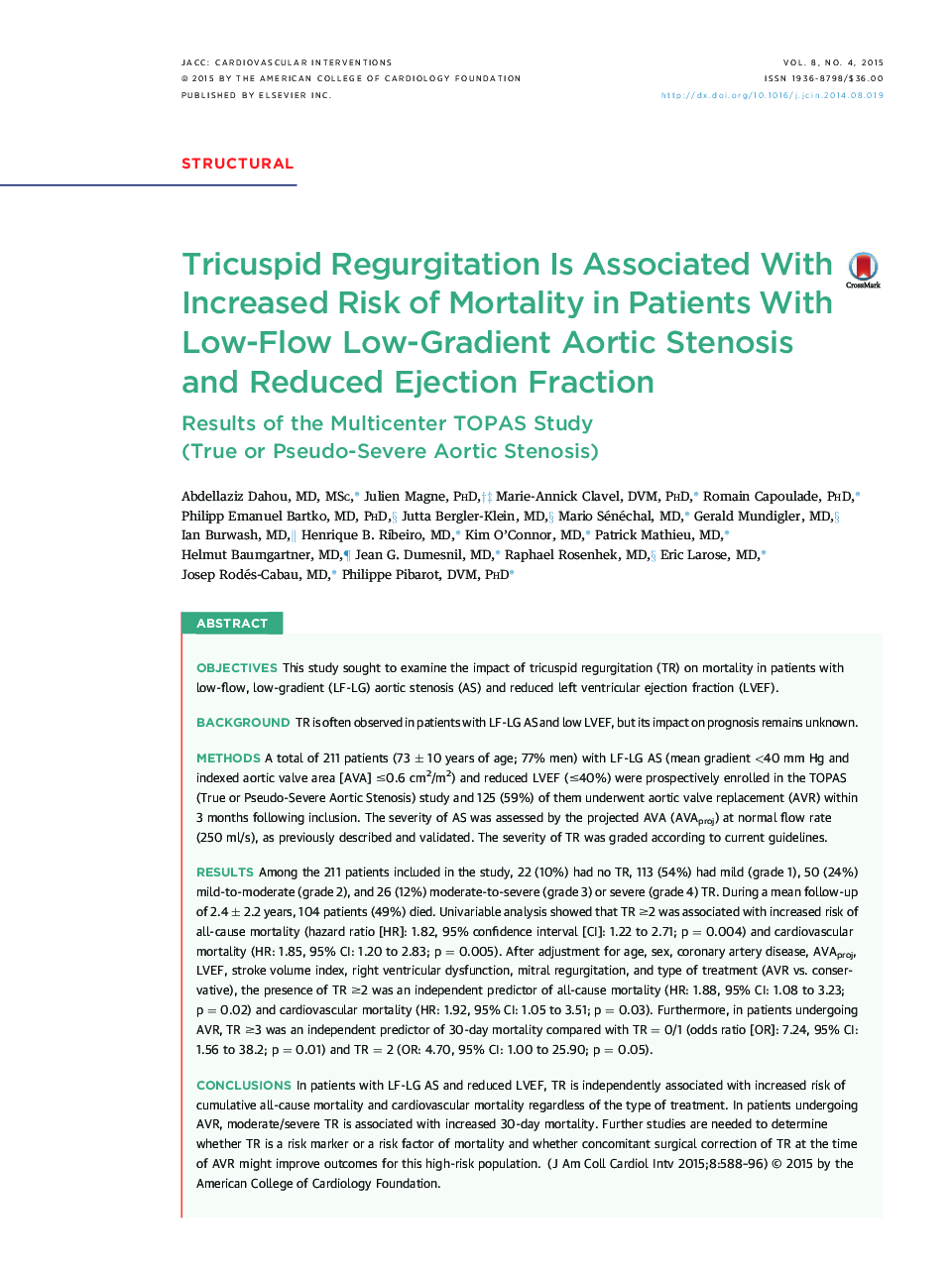| کد مقاله | کد نشریه | سال انتشار | مقاله انگلیسی | نسخه تمام متن |
|---|---|---|---|---|
| 2939753 | 1177002 | 2015 | 9 صفحه PDF | دانلود رایگان |

ObjectivesThis study sought to examine the impact of tricuspid regurgitation (TR) on mortality in patients with low-flow, low-gradient (LF-LG) aortic stenosis (AS) and reduced left ventricular ejection fraction (LVEF).BackgroundTR is often observed in patients with LF-LG AS and low LVEF, but its impact on prognosis remains unknown.MethodsA total of 211 patients (73 ± 10 years of age; 77% men) with LF-LG AS (mean gradient <40 mm Hg and indexed aortic valve area [AVA] ≤0.6 cm2/m2) and reduced LVEF (≤40%) were prospectively enrolled in the TOPAS (True or Pseudo-Severe Aortic Stenosis) study and 125 (59%) of them underwent aortic valve replacement (AVR) within 3 months following inclusion. The severity of AS was assessed by the projected AVA (AVAproj) at normal flow rate (250 ml/s), as previously described and validated. The severity of TR was graded according to current guidelines.ResultsAmong the 211 patients included in the study, 22 (10%) had no TR, 113 (54%) had mild (grade 1), 50 (24%) mild-to-moderate (grade 2), and 26 (12%) moderate-to-severe (grade 3) or severe (grade 4) TR. During a mean follow-up of 2.4 ± 2.2 years, 104 patients (49%) died. Univariable analysis showed that TR ≥2 was associated with increased risk of all-cause mortality (hazard ratio [HR]: 1.82, 95% confidence interval [CI]: 1.22 to 2.71; p = 0.004) and cardiovascular mortality (HR: 1.85, 95% CI: 1.20 to 2.83; p = 0.005). After adjustment for age, sex, coronary artery disease, AVAproj, LVEF, stroke volume index, right ventricular dysfunction, mitral regurgitation, and type of treatment (AVR vs. conservative), the presence of TR ≥2 was an independent predictor of all-cause mortality (HR: 1.88, 95% CI: 1.08 to 3.23; p = 0.02) and cardiovascular mortality (HR: 1.92, 95% CI: 1.05 to 3.51; p = 0.03). Furthermore, in patients undergoing AVR, TR ≥3 was an independent predictor of 30-day mortality compared with TR = 0/1 (odds ratio [OR]: 7.24, 95% CI: 1.56 to 38.2; p = 0.01) and TR = 2 (OR: 4.70, 95% CI: 1.00 to 25.90; p = 0.05).ConclusionsIn patients with LF-LG AS and reduced LVEF, TR is independently associated with increased risk of cumulative all-cause mortality and cardiovascular mortality regardless of the type of treatment. In patients undergoing AVR, moderate/severe TR is associated with increased 30-day mortality. Further studies are needed to determine whether TR is a risk marker or a risk factor of mortality and whether concomitant surgical correction of TR at the time of AVR might improve outcomes for this high-risk population.
Journal: JACC: Cardiovascular Interventions - Volume 8, Issue 4, 20 April 2015, Pages 588–596